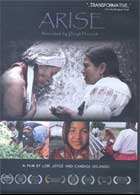
Arise 2013
Distributed by The Video Project, PO Box 411376, San Francisco, CA 94141-1376; 800-475-2638
Produced by Lori Joyce and Candice Orlando
Directed by Lori Joyce and Candice Orlando
DVD, color, 80 min.
Sr. High - General Adult
Africa, Agriculture, Anthropology, Environmentalism, Feminism, Social Movements, Sustainability, Native Americans, India, Sociology
Date Entered: 05/23/2014
Reviewed by Andrew Jenks, California State University, Long BeachThis film documents a key aspect of the environmental justice movement – the linkage of environmental protection to the advancement of women’s rights. Narrated by the famous actress Daryl Hannah, who has devoted much of her time and energy to environmental justice issues, the film follows 13 women in five countries engaged in various environmental initiatives within their communities.
The film ably tells the story of the women who directed these projects, from solar panel assembly classes in rural India to schools for homeless girls in Kenya. Set to music and poetry, and slickly produced and edited, the documentary moves quickly from one part of the world to another, interviewing the activists and visionary women at the heart of these varied projects.
An intense yearning to overcome a sense of alienation from the earth unites all the subjects of this film. They note that modern technological civilization, which has glorified the subjugation and transformation of nature, alienates and distances people from their natural surroundings. The activists featured here are part of a movement to reintegrate people with their inner ecologist, inspired by slogans such as “food justice,” “green-collar jobs,” “food sovereignty,” and “food security.” Particularly interesting is the focus on bringing more environmentally sound and healthy food to poorer communities, who live in what one activist calls “food deserts.” As is painfully clear to anyone who has shopped at Whole Foods – dubbed Whole Paycheck by some shoppers and almost exclusively located in upscale neighborhoods – only the relatively well-to-do can afford to support sustainable farming practices. Yet many advocates of organic farming appear to be blissfully unaware of the economic realities that force people to eat non-organic food produced by the global agro-industrial-chemical complex. As a result, advocates of sustainable farming and organic food often appear as elitist, modern-day Marie Antoinettes telling the junk-food addled masses: “Let them eat quinoa.”
For this reviewer the overall interpretive framework of the film, which imposes a feminist political stance on environmental issues that go far beyond gender, limits the film’s appeal. The film identifies women almost exclusively with environmental protection and the interests of the earth. “It is part of our divine design,” says one activist, regarding the supposedly privileged role of women in the environmental movement. While it is true that women have played a key role in environmental justice movements around the globe, so too have men. The film’s habit of categorizing women as superior nurturers, and thus natural allies in the protection of natural resources against exploitation and destruction, itself reflects a kind of gender stereotype. Identification with the kinds of values and practices promoted in this film – urban farms, non-chemical approaches to farming, a desire to overcome the alienation of modern mechanical and technological life, compassion for wild creatures and habitats, reestablishing links between local vegetable producers and consumers – are not just feminine practices.
The film also presents a vision of indigenous peoples as somehow living in balance and harmony with their environment, unlike the peoples of modern civilization. Though the latter is certainly true, the idealized and at times clichéd image of indigenous peoples presented in the film ignores the evidence that many ancient civilizations and cultures exhausted and overused resources. Only the relatively less rapacious technology of the pre-modern era prevented that attitude from having the same disastrous consequences as it has had for our world.
For all these reasons the film has an archaic feel, a throwback to a 1960s sensibility, contrasting mainstream “male” values and culture with the organic counterculture led by women in defense of Mother Earth, and urging a return to the supposedly more holistic and compassionate native cultures. Ultimately, thinking more critically about the relationship between gender, native cultures and the environment would have made this good film even better.
Awards
- Winner, Spirit of Activism, Colorado Environmental Film Festival